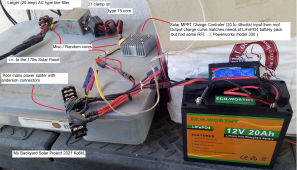ko6kL
New Member
- Joined
- Oct 13, 2021
- Messages
- 74
Okay I m a ham and running noise filters on the input and outputs of the Sollar change controller ( ~13v@30amps)
I wanted to make sure if the noise filter failed( shorted) the SCC and battery ( 208ah ) were protected from
a short in the filter. I'm thinking this needs to be a connected dual pole breaker so it removes the PV input at the same time from
the SCC if the CB trips from an output short...
Iv Read that the SCC needs the battery connection BEFORE the PV power...
Does this make sense?

most of the DC dual pole linked breakers on amazon are marked with (+)and (-) on each of the connections ( this would require a 4 pole =$$) ,
really I think just need to be in the plus line and no need to break the negative line.... is there a better selection for this job?
I needed to upgrade the hardware to something like above
 as this sort of little the inline modular blade fuses were running a little hot.
as this sort of little the inline modular blade fuses were running a little hot.
this 100PV-volt input 12@30amp SCC is this model and I am finding it is very clean on the radio static, I'm only seeing a little around 60mhz ( not a ham band in the USA )
much better than the other two leading ham radio SCC's. ( Apolo16 and Radioworks300 I have all 3 )

I wanted to make sure if the noise filter failed( shorted) the SCC and battery ( 208ah ) were protected from
a short in the filter. I'm thinking this needs to be a connected dual pole breaker so it removes the PV input at the same time from
the SCC if the CB trips from an output short...
Iv Read that the SCC needs the battery connection BEFORE the PV power...
Does this make sense?

most of the DC dual pole linked breakers on amazon are marked with (+)and (-) on each of the connections ( this would require a 4 pole =$$) ,
really I think just need to be in the plus line and no need to break the negative line.... is there a better selection for this job?
I needed to upgrade the hardware to something like above

this 100PV-volt input 12@30amp SCC is this model and I am finding it is very clean on the radio static, I'm only seeing a little around 60mhz ( not a ham band in the USA )
much better than the other two leading ham radio SCC's. ( Apolo16 and Radioworks300 I have all 3 )







